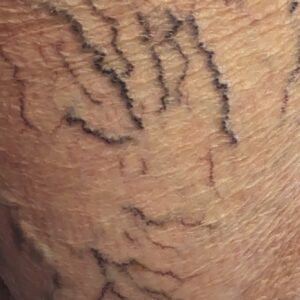Spider Veins: What Are They and How to Remove Them?
Introduction to Spider Veins
 Spider veins, also known as telangiectasias, are small, damaged veins that commonly appear on the face, legs, or other areas of the body. These veins form when small blood vessels under the skin dilate, becoming visible as red, blue, or purple web-like patterns. While often considered a cosmetic concern, spider veins can also indicate early signs of venous disease, a condition that affects proper blood flow.
Spider veins, also known as telangiectasias, are small, damaged veins that commonly appear on the face, legs, or other areas of the body. These veins form when small blood vessels under the skin dilate, becoming visible as red, blue, or purple web-like patterns. While often considered a cosmetic concern, spider veins can also indicate early signs of venous disease, a condition that affects proper blood flow.
Although spider veins are more prevalent in women and tend to increase with age, anyone can develop them. To prevent recurrence, it’s essential to have your veins evaluated by a qualified vein specialist, as underlying venous conditions might contribute to their formation.
Understanding Spider Veins and Their Symptoms
Spider veins can present in various patterns, such as linear, starburst, or tree-like formations. They often appear on the legs, including the inner thighs, ankles, and calves, but can also develop on the face or other body areas. In some cases, spider veins may signal an underlying condition called venous insufficiency, which requires medical evaluation.
It’s important to differentiate spider veins from varicose veins:
- Spider veins are smaller (less than 1mm in diameter), closer to the skin’s surface, and typically painless.
- Varicose veins are larger, twisted, and may cause discomfort or swelling.
Spider veins are commonly treated for cosmetic reasons, whereas varicose veins are often addressed due to medical necessity.
Causes and Risk Factors
Several factors contribute to the development of spider veins, including:
- Genetics: Family history plays a significant role.
- Age: Vein elasticity decreases over time.
- Gender: Hormonal changes during pregnancy, menopause, or hormonal treatments increase the risk.
- Pregnancy: Increased blood volume and pressure strain veins.
- Lifestyle: Long periods of standing or sitting can weaken vein walls.
- Obesity: Extra weight puts pressure on veins.
- Injury or trauma: Can damage vein structures.
How to Minimize Risk
While some causes are uncontrollable, taking proactive measures can help reduce the likelihood of developing spider veins:
- Wear compression stockings to improve circulation.
- Maintain a healthy weight to minimize vein pressure.
- Avoid prolonged standing or sitting.
- Protect your skin from UV exposure with sunscreen.
Diagnosis of Spider Veins
Most patients recognize spider veins by their appearance. However, if symptoms like leg heaviness, tenderness, or swelling occur, a diagnostic ultrasound may be recommended. This test identifies underlying venous issues like varicose veins or venous insufficiency, ensuring that treatment addresses the root cause. Treating spider veins without diagnosing underlying conditions may result in recurrence or complications.
Sclerotherapy Treatment for Spider Veins

Why choose sclerotherapy?
- Safe and effective.
- Minimally invasive, with little to no downtime.
- Results in noticeable improvement after just a few sessions.
Success rate?
While individual results may vary, approximately 80% of patients experience significant improvement with sclerotherapy. Multiple sessions may be required for optimal results, depending on the extent and location of the spider veins.
Is sclerotherapy painful?
Sclerotherapy is generally well-tolerated. Patients may feel a slight stinging sensation during the injection, but discomfort is minimal and brief. In rare cases, a numbing agent can be applied for added comfort.
Alternatives to Sclerotherapy
For those seeking alternatives, laser treatment is another effective option for spider vein removal. Laser therapy uses concentrated light to heat the vein, causing it to scar and close. This option is ideal for treating smaller spider veins, especially on the face and chest.
- Effectiveness: Both are effective, but sclerotherapy is better for larger veins.
- Pain: Laser treatment is often more painful than sclerotherapy.
- Target Area: Laser works best for smaller facial veins; sclerotherapy is more effective on leg veins.
Can Spider Veins be Removed Permanently?
Spider veins can return, though typically in a less prominent form. Genetics, lifestyle, and underlying venous health play a role in recurrence. The tendency to get spider veins is somewhat genetic like the tendency to get freckles or age spots. Many patients opt for maintenance treatments, such as periodic sclerotherapy sessions, to keep their legs looking smooth and healthy.
Scheduling Spider Vein Removal
Taking the first step toward vein treatment is simple. Schedule your consultation today by calling our office or using our appointment request form. For the best results, bring or purchase compression stockings, as they play a vital role in post-treatment recovery.
